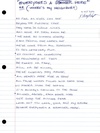
Transcription
IS IT LOVE —
WHEN IT DOES NOT HOLD
YOUR ATTENTION? WHEN IT DOES
NOT CONTRIBUTE TO YOUR PEACE AND
CLARITY? — IS IT LOVE WHEN
YOU CANNOT SEE BEAUTY AND
POISE? BUT MOST OF ALL
IS IT LOVING WHEN WE
ARE NOT
AWARE?
[a coloring page with decorative hearts and "Love" written in cursive, colored in with crayons]
To my Friend
From Mama Jude
2/17
[a coloring page with a word bubble, a peace sign, stars, and hearts, containing the following quote:
Don't look for big things,
just do small things with
great love.
—Mother Teresa]
Hi,
I'm learning how to "stay in the lines". I'm also learning that an occassional slip is not critical.
[a hand-drawn smiley face]
JUST SO THAT YOU CAN "KNOW", AND NOT SAY, "I DID NOT KNOW."
Francis Scott Key Biography
Poet, Lawyer (1779—1843)
Synopsis
Born on August 1, 1779, in Frederick County, Maryland, Francis Scott Key became a lawyer who witnessed the British attack on Fort McHenry during the War of 1812. The fort withstood the day-long assault, inspiring Key to write a poem that would become the future U.S. national anthem, "The Star-Spangled Banner." Key later served as a district attorney for Washington, D.C. He died on January 11, 1843.
Early Life and Career
Francis Scott Key was born on August 1, 1779, in Frederick County, Maryland, to a wealthy clan on the plantation of Terra Rubra. He was educated at home until the age of 10 and then attended an Annapolis grammar school. He went on to study at St. John's College, ultimately returning to his home county to set up practice as a lawyer. Key and Mary "Polly" Taylor Lloyd in the early 1800s, and the couple would go on to have 11 children. By 1805, he'd set up his legal practice in Georgetown, part of Washington, D.C.
Crafting 'The Star-Spangled Banner'
On September 13, the three at sea watched what would become a day-long assault. After continual bombing, to Key's surprise, the British weren't able to destroy the fort, and Key noted upon the dawning of the next morning a large U.S. flag being flown. (It had in fact been sewn by Mary Young Pickersgill at the request of the fort commander.)
The British ceased their attack and left the area. Key immediately wrote down the words for a poem that he would continue composing at an inn the next day. The work, which relied heavily on visualizations of what he witnessed, would come to be known as the "Defence of Fort M'Henry" and was printed in handbills and newspapers, including the Baltimore Patriot. The poem was later set to the tune of a drinking song by John Stafford Smith, "To Anacreon in Heaven," and came to be called "The Star-Spangled Banner."
Stance on Slavery
Key continued working in law and became Washington, D.C., district attorney in 1833. He also had a complex, some might say contradictory, stance on race. In his capacity as district attorney, he was noted to have overseen proceedings that upheld the system of slavery, prosecuting abolitionists. Key was a slave owner himself, though he went on record as saying that the system of slavery was full of sin and "a bed of torture." He also helped establish the American Colonization Society, which advocated the transport of African Americans to Africa. Information on Key's relationship to race and his D.C. legal career can be found in the Jefferson Morley book Snow-Storm in August: Washington City, Francis Scott Key, and the Forgotten Race Riot of 1835.
Other posts by this author
|
2021 jun 24

|
2021 jan 26

|
2020 dec 28

|
2019 nov 17

|
2019 nov 17

|
2019 nov 17

|
More... |





Replies